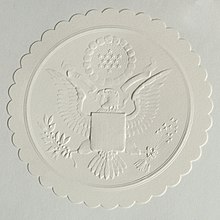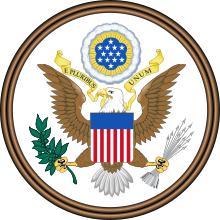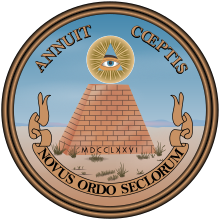Great Seal of the United States

The Great Seal of the United States ( English Great Seal of the United States ) is the official stamp and emblem of the United States of America . The front of the seal shows the bald eagle , while the back shows an unfinished pyramid over which the eye of providence is emblazoned. The seal was introduced in 1782 and is often used in official documents similar to a coat of arms . Both sides of the seal are also shown on the reverse of the one dollar banknote .
front
The eagle holds an olive branch in its claws on the one hand, and a bundle of arrows on the other , which is intended to express readiness for peace, but also for battle. Symbolically, the emphasis is on the olive branch, as it is on the heraldic right- hand side of the seal: in heraldry , the right-hand side indicates the more positive. In its beak it carries a scroll with the Latin inscription E pluribus unum (“From many one”). This is supposed to represent the union of the thirteen colonies that declared their independence from Great Britain in 1776 and united to form the USA.
The eagle always looked to the right on the seal. The viewing direction is not specified in the blazon , but because in heraldry the viewing direction to the right is the unmarked one , and the olive branch was intended for the right side, one can assume that it was originally meant that way. In addition, Charles Thomson , who proposed the last version of the seal and wrote the blazon, also chose this line of sight in the draft sketch . Only on the US President's seal did the eagle look to the left earlier. An example of this is the emblem on the Resolute Desk , the desk in the Oval Office . President Truman changed direction on October 26, 1945 to symbolize America's pursuit of peace.
Above the eagle there are 13 pentagram-like stars in a golden wreath in the form of a hexagram on a light blue background. The thirteen as a symbol for the 13 founding states of the USA can also be found in the number of arrows, the olive leaves and the olives on them; like Annuit Coeptis, the motto E pluribus unum has 13 letters on the back. The shield also has 13 stripes, seven white and six red, unlike the United States flag , which has seven red and six white stripes.
back
The four-sided, unfinished Egyptian pyramid on the back has 13 steps and symbolizes the constitution of the USA, i.e. the new beginning. The Eye of Providence , which is emblazoned above the pyramid together with the Latin word Annuit coeptis, nods graciously to this new beginning . The symbol of the all-seeing eye stands for the Christian God . It was originally borrowed from Christian iconography , but can also be found among the symbols of Freemasonry . According to Michael Stolleis , the fact that it is an Egyptian and masonry pyramid points to Freemasonry and Illuminati , i.e. to Enlightenment. The Roman number MDCCLXXVI (1776), the year of the declaration of independence, is engraved on the foundation block of the masonry pyramid . The pyramid can be understood as an allusion to the exodus from Egypt , as it is told in the second book of Moses of the Bible. To that extent it symbolizes the freedom of the United States.
The unfinished pyramid is also a symbol that the US still has to work on its completion. The motto Annuit coeptis ( Latin "He was gracious to the beginning") adds the divine blessing to this symbolism of a new beginning. The saying is a modified quote from Virgil's Aeneid . There it says: "Jupiter omnipotens, audacibus annue cœptis" ("Mightiest Jupiter , be suited to the bold beginning."). A heraldically unusual element is the naturalistic representation of 13 bushes and shrubs on the foundation of the pyramid. The three-dimensional representation of the pyramid is also out of the ordinary in heraldry. The number of visible stone blocks fluctuates in the various representations, in the current version from 1972 and in the one from 1900 there are 79.
The writing Novus ordo seclorum (Latin for "a new order of the ages"), which is located below the pyramid, is a modified quote from the fourth eclogue by Virgil: "Magnus ab integro sæclorum nascitur ordo" ("The great succession of the ages starts again "). The context of the fourth eclogue was interpreted by the Church Fathers as a prophecy of the birth of Christ and the new age that began with it. By the American revolutionaries, however, Virgil's verse is politically understood as a reminder of the split from Great Britain and is also to be interpreted as a subtle message to the effect that the end of the British Empire has now begun. The idea of a new age also alludes to the emancipation of the “new world” , which is leaving behind it the “old” Europe in a double sense (the ancien régime is understood here as an “outdated” order). The ingenious game of imperial sayings referring back to the Roman Empire is part of the cultural repertoire of modern great powers and their competitions for symbolically marked claims to leadership.
Against this background, the adaptation of Virgil's Eclogue in particular represents a complex intellectual provocation with religious undertones and an instrument for creating national meaning: It combines allusions to the birth of Jesus with the biblical redemption motif of the excerpt (although historically absurd but traditionally passed on through earlier references) the Egyptian bondage ( Exodus ) as well as with the end of the Roman Civil War and the rise of ancient Rome under Caesar and Augustus to become a world empire . Since the educational horizon of the time, which was decisive for the elite-backed politics of the early USA, did not make a sharp distinction between republican Rome and imperial Rome, it is questionable whether the seal also refers to the end of the internal American civil war embedded in the American Revolution (royalist minorities devoted to the English motherland arguments with the early national revolutionaries) alludes to.
In general, political ideas, some of which are contradicting one another and originating from different cultures, are deliberately ambiguous and extremely artfully interwoven in the seal: for example the idea of a new order, furthermore the secularized motive of an originally theological redemption (in this case through the political freedom of the American Revolution Republic ), political proselytizing in the sense of enlightenment and general democratization as well as the religiously inspired idea of the early American settlers and founding fathers that they have found the Promised Land. Thus, the back of the Great Seal refers in turn to its front and the motto E pluribus unum , which has been successfully claimed for the immigration society of the USA - perhaps also in the sense of “united in diversity”.
In addition, it has been emphasized that all these features transformed the cyclical concept of time typical of Virgil and the ancient theory of history into a linear idea of progress characteristic of modern times . In her book About the Revolution, Hannah Arendt interpreted the self-image of the American Revolution symbolically captured in the seal as both the definitive end of antiquity and the modern beginning of human history. The fact that Aeneas, who fled Troy, which was defeated by the Greeks, is passed on as the legendary founder of Rome and the ideal founder of the United States, underlines the self-confidence of the still young USA. Especially in the 20th century and up to the present day, the political messages, winged words and imperial motifs of the Great Seal are used again and again in political rhetoric and political theology of the USA for domestic political purposes and also to promote a “ new world order ” been.
history
Immediately after the declaration of independence, the second continental congress decided to commission a seal for the newly founded state. A committee consisting of Benjamin Franklin , John Adams and Thomas Jefferson , all three of whom were inexperienced in heraldry, was assigned to draw up a draft. Therefore they enlisted the help of the artist Pierre Eugène du Simitière , who contributed the year and the all-seeing eye (still without a triangle, only with rays). In 1780 a second committee was set up, consisting of James Lovell , John Morin Scott and William Churchill Houston , who let Francis Hopkinson help them with drawing; from this comes the pyramid (without the all-seeing eye), which he originally designed in 1778 for a 50-dollar bill. In 1782 a third committee was set up, which included Arthur Middleton , Elias Boudinot and John Rutledge , who was soon replaced by Arthur Lee . This committee left the drawing work mainly to William Barton . His idea was to join the pyramid and the eye of providence. He suggested the heading Deo favente (Latin for “with God's favor”) as part of the text and Perennis (Latin for “permanent”) as the signature . The final draft comes from Charles Thomson , who brought together the work of the three committees and incorporated the Virgil quotations. His report was adopted by Congress on June 20, 1782.
use
The official name is Great Seal, although there is no small state seal of the United States. This is because the English king had kept a large seal for state affairs and a small seal for his private affairs from the time of King John Ohneland .
The seal serves several purposes: On the one hand, it is used as a seal for various official documents, unless the use of another seal (such as the seal of the President) is required. For this purpose, the only official sealing press located in the US State Department's exhibition hall is used approximately 2,000 to 3,000 times a year. Only the front of the seal can be seen here.

In addition, the colored version of the seal with its front and back is used as the national coat of arms of the United States, for example on government buildings, US embassies and consulates or on the one-dollar bill.
conspiracy theories
For many conspiracy theorists, the symbolism of the Great Seal is important proof that the Illuminati Order or the Freemasons , in the context of a global conspiracy , were the decisive driving force behind the American War of Independence and still determine US politics today. The Canadian author William Guy Carr (1895-1959) claimed as early as the 1950s in his writings Pawns in the Game and Red Fog over America that the all-seeing eye above the pyramid was the symbol of the Illuminati - but without providing any proof. This was the starting point for various discussions. Popular examples of their processing in novels are Robert Anton Wilson and Robert Shea's novel trilogy Illuminatus! from 1975 and Dan Brown's thriller Angels and Demons from 2000 (German title: Illuminati ).
Carr suspects in his book z. B. that the pyramid as an alleged symbol of the Illuminati, by tactics of Henry A. Wallace (1888-1965), Vice President in the government under Franklin D. Roosevelt and alleged Illuminat, its place in the seal of the USA and thus on the US Dollar found. However, the seal of the USA in 1782, d. H. Completed long before his birth, and so the only link to the Illuminati is that they were also founded in Bavaria in 1776 by Adam Weishaupt . The order of the Illuminati did not use the pyramid in its symbolism, but the owl of Minerva .
According to other conspiracy theories, in the early drafts of the seal, the bird on the obverse was not an eagle but a phoenix , a Masonic symbol of resurrection and renewal. This supposedly proves that the US should become a resurrected Atlantis under the aegis of the Freemasons. The number of feathers on each wing indicates the 33 degrees of the Scottish Rite. The Latin quotes on the scroll in the eagle's beak are interpreted as an indication of world domination or the “ New World Order ” of a world government without sovereign nation-states, which the Freemasons would supposedly strive for.
Many conventional historians also interpret the symbolism of the seal as having a Masonic influence. They do not see any evidence of conspiracies in it, but assume that the creators of the seal used these symbols simply because they were familiar with them.
See also
- United States flag
- Flags and seals of the US states
- Pledge of Allegiance (United States Oath of Allegiance )
literature
- Richard S. Patterson, Dougall Richardson: The Eagle and the Shield: A History of the Great Seal of the United States . Department of State Publication 8900; Department and Foreign Service Series 161. Office of the Historian, Bureau of Public Affairs, Department of State, under the auspices of the American Revolution Bicentennial Administration, Washington 1978.
- Thomas White: Dollar Bill. In: Peter Knight (Ed.): Conspiracy Theories in American History. To Encyclopedia . Volume 1, ABC Clio, Santa Barbara / Denver / London 2003, p. 226.
Web links
- www.greatseal.com by John D. MacArthur, 76 pages - Information on the US seal
- The Great Seal of the United States (Publication No. 10411. Washington, DC: United States Department of State - Bureau of Public Affairs, September 1996) - Detailed description of the American State Department, 25 pages, PDF (English)
Individual evidence
- ↑ Michael Stolleis : The eye of the law. Materials for a modern metaphor. In: Jahrbuch des Historische Kollegs 2001 , p. 34 ( online , accessed November 25, 2017).
- ↑ Michael Stolleis : The eye of the law. Materials for a modern metaphor. In: Jahrbuch des Historische Kolleg 2001 , pp. 15–43, here p. 34 ( online , accessed on May 20, 2020)
- ↑ Thomas White: Dollar Bill. In: Peter Knight (Ed.): Conspiracy Theories in American History. To Encyclopedia . Volume 1, ABC Clio, Santa Barbara, Denver and London 2003, p. 226.
- ↑ The largest money factory in the USA A podcast broadcast by Anja Steinbuch and Michael Marek on Bayern 2 from May 16, 2019 - manuscript of the series p. 6 (PDF file) accessed on August 18, 2019
- ↑ a b c Sebastian Huhnholz: Crisis imperiality. Rome reference in the US empire discourse . Campus, Frankfurt am Main and New York 2014, p. 227-239 .
- ↑ Hannah Arendt: About the revolution . Piper, Munich 1963, p. 267 .
- ↑ US Department of State, Bureau of Public Affairs (ed.), The Great Seal of the United States, Washington, DC, 2003 (PDF; 3.2 MB), p. 3.
- ↑ US Department of State, Bureau of Public Affairs (ed.), The Great Seal of the United States, Washington, DC, 2003 (PDF; 3.2 MB), p. 12.
- ↑ US Department of State, Bureau of Public Affairs (ed.), The Great Seal of the United States, Washington, DC, 2003 (PDF; 3.2 MB), p. 13 f.
- ↑ Joachim Körber: The science with Dan Brown . Wiley-VCH Verlag, Weinheim 2009, p. 197.
- ↑ Thomas White: Dollar Bill. In: Peter Knight (Ed.): Conspiracy Theories in American History. To Encyclopedia . Volume 1, ABC Clio, Santa Barbara / Denver / London 2003, p. 226 f.
- ↑ Thomas White: Dollar Bill. In: Peter Knight (Ed.): Conspiracy Theories in American History. To Encyclopedia . Volume 1, ABC Clio, Santa Barbara / Denver / London 2003, p. 227.






